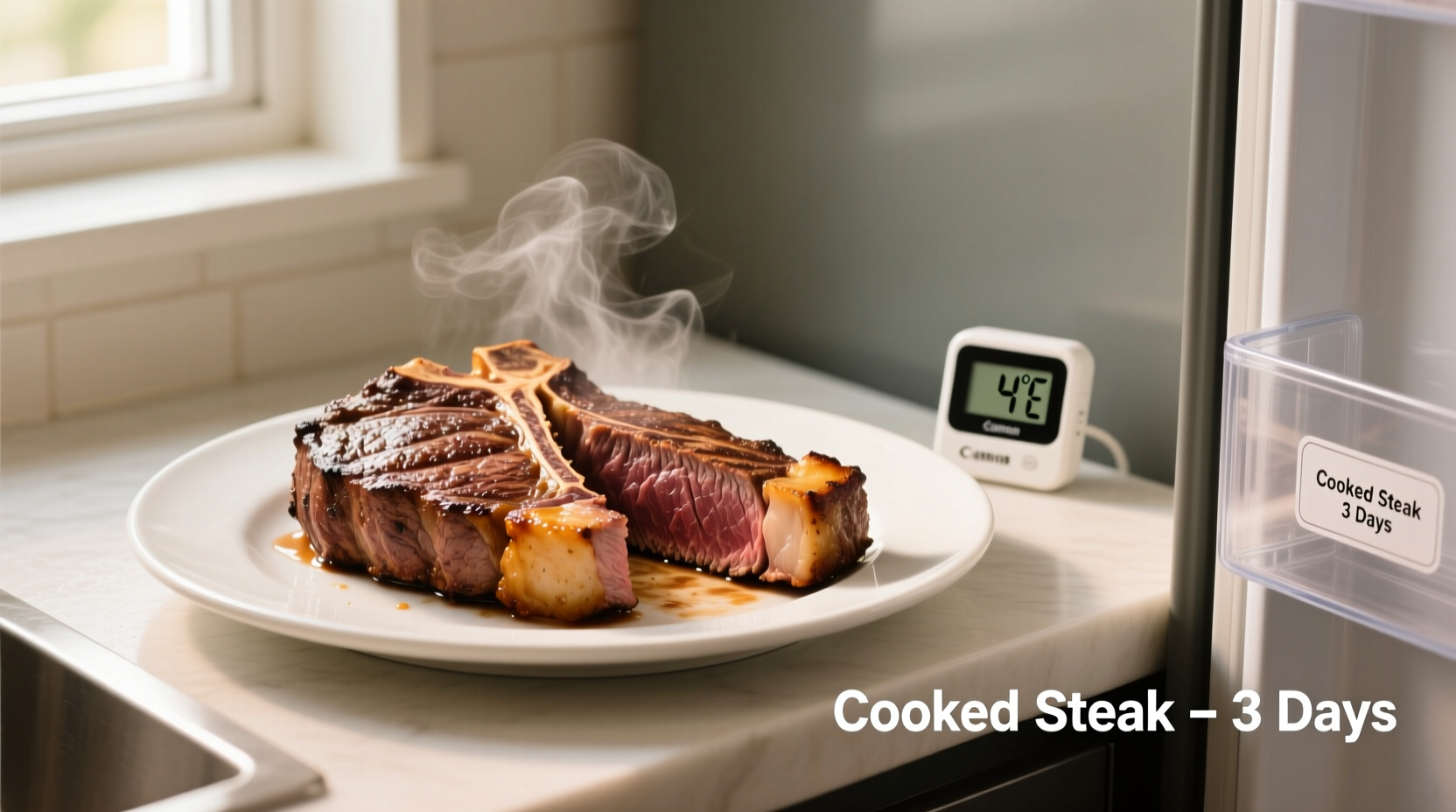Wondering if that leftover steak in your fridge is still good? You're not alone. Every year, millions of people face this dilemma, potentially risking foodborne illness by consuming spoiled meat. Understanding the precise shelf life of cooked steak isn't just about avoiding waste—it's a critical food safety practice that protects you and your family.
Why the 3-4 Day Rule Matters for Cooked Steak
When you cook steak, you eliminate harmful bacteria through heat. However, once it cools, any bacteria present in your kitchen environment can begin to multiply. The USDA Food Safety and Inspection Service clearly states that cooked meat products, including steak, maintain safety for only 3-4 days under proper refrigeration.
This timeframe isn't arbitrary—it's based on bacterial growth rates. Between 40°F and 140°F lies the "danger zone" where bacteria like Salmonella and E. coli multiply rapidly. Even in a properly chilled refrigerator, some bacteria continue growing, albeit more slowly.
| Storage Method | Temperature | Safe Storage Time | Quality Considerations |
|---|---|---|---|
| Refrigerator | 40°F (4°C) or below | 3-4 days | Best quality within first 72 hours |
| Freezer | 0°F (-18°C) or below | 2-3 months | Use freezer-safe packaging to prevent freezer burn |
| Room Temperature | Above 40°F (4°C) | 2 hours maximum | Discard if left out longer, especially in warm conditions |
Proper Storage Techniques That Extend Steak Freshness
How you store your cooked steak significantly impacts its actual shelf life. Follow these professional kitchen practices:
- Cool quickly: Divide large portions into smaller containers to reduce cooling time—steak should reach refrigerator temperature within 2 hours of cooking
- Air-tight containers: Use glass or BPA-free plastic containers with tight seals, or vacuum-sealed bags to prevent moisture loss and odor absorption
- Strategic placement: Store on middle refrigerator shelves, not in the door where temperature fluctuates most
- Temperature verification: Use a refrigerator thermometer to confirm your appliance maintains 40°F or below—many built-in thermometers are inaccurate

Signs Your Cooked Steak Has Spoiled (Beyond the 4-Day Mark)
While the 3-4 day guideline provides a safety margin, visual and sensory cues offer definitive indicators of spoilage:
- Texture changes: Slimy or sticky surface that feels tacky to the touch
- Odor development: Sour, ammonia-like, or generally unpleasant smell (fresh cooked steak has minimal aroma)
- Color shifts: Grayish-brown discoloration beyond normal oxidation, or greenish spots
- Mold appearance: Any visible fuzzy growth, even in small amounts
When in doubt, throw it out. The USDA emphasizes that you cannot smell or see all harmful bacteria—relying solely on sensory evaluation is unsafe.
Maximizing Quality Within the Safety Window
Professional chefs know that quality degrades before safety becomes compromised. For optimal eating experience:
- Day 1-2: Steak maintains near-fresh quality, ideal for reheating
- Day 3: Slight moisture loss may occur, but still excellent quality
- Day 4: Texture begins to change; best used in dishes like steak sandwiches or stir-fries
For meal preppers, the FDA Food Code recommends labeling containers with cooking dates to track freshness accurately. This simple practice reduces food waste while maintaining safety.
Safe Reheating Practices for Leftover Steak
Proper reheating can restore quality while ensuring safety:
- Internal temperature check: Reheat to 165°F (74°C) minimum, verified with a food thermometer
- Gentle methods: For best results, warm slowly in a covered skillet over low heat with a splash of broth
- Avoid microwave reheating: This often creates uneven heating and tough texture
- Single reheating only: Never reheat and re-refrigerate multiple times
When Freezing Makes Sense for Leftover Steak
If you won't consume your cooked steak within 3-4 days, freezing extends safety while preserving quality:
- Wrap tightly in freezer paper or vacuum-seal to prevent freezer burn
- Portion into single servings for convenient thawing
- Label with date—frozen cooked steak maintains best quality for 2-3 months
- Thaw overnight in refrigerator, never at room temperature
According to university extension food safety programs, properly frozen cooked steak retains safety indefinitely, though quality diminishes after 3 months. The National Center for Home Food Preservation confirms that freezer storage halts bacterial growth completely.
Special Considerations for Different Steak Types
While the 3-4 day rule applies broadly, certain steak preparations affect shelf life:
- Fatty cuts (like ribeye): May develop rancidity faster due to fat oxidation
- Marinated steaks: Acidic components can slightly extend freshness but monitor closely for texture changes
- Leftover steak dishes (stroganoff, fajitas): Follow the shortest shelf life of any ingredient
Remember that food safety guidelines exist because foodborne illness causes approximately 48 million illnesses annually in the United States, per CDC data. Following proper storage protocols isn't just about quality—it's a critical health practice.
Practical Food Safety Checklist for Leftover Steak
Before storing or consuming leftover steak, verify these critical points:
- Refrigerator temperature is at or below 40°F (4°C)
- Steak was refrigerated within 2 hours of cooking (1 hour if room temperature exceeds 90°F)
- No visible signs of spoilage (sliminess, off-odors, discoloration)
- Storage container is properly sealed and dated
- Reheating reaches 165°F (74°C) internal temperature











 浙公网安备
33010002000092号
浙公网安备
33010002000092号 浙B2-20120091-4
浙B2-20120091-4